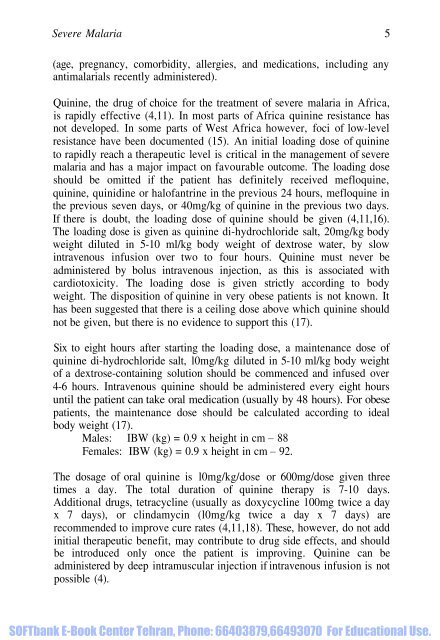SOFTbank E-Book Center Tehran, Phone: 66403879,66493070 For ...
SOFTbank E-Book Center Tehran, Phone: 66403879,66493070 For ...
SOFTbank E-Book Center Tehran, Phone: 66403879,66493070 For ...
You also want an ePaper? Increase the reach of your titles
YUMPU automatically turns print PDFs into web optimized ePapers that Google loves.
Severe Malaria 5<br />
(age, pregnancy, comorbidity, allergies, and medications, including any<br />
antimalarials recently administered).<br />
Quinine, the drug of choice for the treatment of severe malaria in Africa,<br />
is rapidly effective (4,11). In most parts of Africa quinine resistance has<br />
not developed. In some parts of West Africa however, foci of low-level<br />
resistance have been documented (15). An initial loading dose of quinine<br />
to rapidly reach a therapeutic level is critical in the management of severe<br />
malaria and has a major impact on favourable outcome. The loading dose<br />
should be omitted if the patient has definitely received mefloquine,<br />
quinine, quinidine or halofantrine in the previous 24 hours, mefloquine in<br />
the previous seven days, or 40mg/kg of quinine in the previous two days.<br />
If there is doubt, the loading dose of quinine should be given (4,11,16).<br />
The loading dose is given as quinine di-hydrochloride salt, 20mg/kg body<br />
weight diluted in 5-10 ml/kg body weight of dextrose water, by slow<br />
intravenous infusion over two to four hours. Quinine must never be<br />
administered by bolus intravenous injection, as this is associated with<br />
cardiotoxicity. The loading dose is given strictly according to body<br />
weight. The disposition of quinine in very obese patients is not known. It<br />
has been suggested that there is a ceiling dose above which quinine should<br />
not be given, but there is no evidence to support this (17).<br />
Six to eight hours after starting the loading dose, a maintenance dose of<br />
quinine di-hydrochloride salt, l0mg/kg diluted in 5-10 ml/kg body weight<br />
of a dextrose-containing solution should be commenced and infused over<br />
4-6 hours. Intravenous quinine should be administered every eight hours<br />
until the patient can take oral medication (usually by 48 hours). <strong>For</strong> obese<br />
patients, the maintenance dose should be calculated according to ideal<br />
body weight (17).<br />
Males: IBW (kg) = 0.9 x height in cm – 88<br />
Females: IBW (kg) = 0.9 x height in cm – 92.<br />
The dosage of oral quinine is l0mg/kg/dose or 600mg/dose given three<br />
times a day. The total duration of quinine therapy is 7-10 days.<br />
Additional drugs, tetracycline (usually as doxycycline 100mg twice a day<br />
x 7 days), or clindamycin (l0mg/kg twice a day x 7 days) are<br />
recommended to improve cure rates (4,11,18). These, however, do not add<br />
initial therapeutic benefit, may contribute to drug side effects, and should<br />
be introduced only once the patient is improving. Quinine can be<br />
administered by deep intramuscular injection if intravenous infusion is not<br />
possible (4).<br />
<strong>SOFTbank</strong> E-<strong>Book</strong> <strong>Center</strong> <strong>Tehran</strong>, <strong>Phone</strong>: <strong>66403879</strong>,<strong>66493070</strong> <strong>For</strong> Educational Use.





